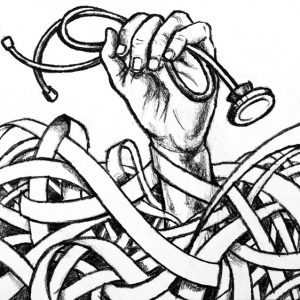by Robert A. Duke
Allan Pinkerton of detective fame devised the first Rogues Gallery in 1855. It was a compilation of descriptions, methods of operation, hiding places and names of criminals and their associates.
My rogues’ gallery doesn’t feature criminals but rather a collection of medical specialists notable for their shared qualities and characteristics typically detrimental to patients. Patients and caregivers want accurate information promptly — a rarity these days.
Specialists’ findings are typically incomplete or tardy and not adequately coordinated with the referring physician and patient. Referral from your primary care physician (PCP) is more likely to complicate and delay care than it is to expedite diagnosis or treatment.
In my experience, PCPs make referrals to specialist to safeguard themselves from malpractice risks, and specialists, in turn, see referrals as someone else’s patient; that’s patient limbo. For me — the patient — I’d rather the PCP would consult with the specialist or other expert source himself before involving another whole medical practice in an incident of care. The two don’t work together well, I’ve found.
No one knows a patient’s health better than his/her primary care physician, and a PCP can provide more care and more quickly than a specialist if that patient is willing to consider negotiating with the PCP over referrals.
There are many published protocols for diseases and conditions where the next steps in treatment are well established, documented, and available for easy reference by you and your PCP. Like justice, treatment delayed is treatment denied. Following the conventional specialist’s path to diagnosis and treatment can be arduous, risky and hazardous as shown in the following gallery postings:
Rheumatologist A
When a routine blood test showed I had developed polymyalgia rheumatic (PMR), my PCP referred me to a rheumatologist, who put me on a regimen of decreasing doses of prednisone (a corticosteroid) with the goal of reaching a maintenance level of 10mg per day and ordered a suite of blood test to measure my condition. She had the test results within a week but didn’t present them until our next scheduled appointment, at which time I requested a written report for my PCP and me. When a month later I’d received nothing, I asked my PCP to follow up, and two months after my initial specialist appointment my PCP, and I received a report or, to be more precise, half of a report. Additional symptoms of PMR can include giant cell arteritis, an inflammation of arteries, which can lead to blindness and stroke. My specialist’s report addressed only PMR, but made no mention of the arteritis. It was just as important to be told explicitly what disease I had, as well as explicitly what symptoms I didn’t have. It left me wondering and worried. So, after two months I was forced to continue pursuing a complete diagnosis, hardly fair or practical.
Rheumatologist B
When my PCP and I became dissatisfied with rheumatologist A, he referred me to a second rheumatologist. This rheumatologist immediately put me on a different regimen to reduce my daily prednisone from rheumatologist A’s 10mg daily to 1mg, with a goal of reaching zero prednisone. Instead of blood tests, this specialist relied on monitoring my physiological symptoms to determine the course of my PMR. Without determining whether my shoulder and hip pain were wholly caused by PMR, rheumatologist B kept me on prednisone for what I estimated was one year longer than necessary. I finally ordered my own blood test and, based on the results, I quit taking prednisone. All the same symptoms can be caused by peripheral neuropathy, an autoimmune disease, and continuing symptoms may no longer be the result of PMR after treatment, but might result from an underlying condition.
Physical Therapist
Over six months, I had fallen 50 times before I stopped counting. I had been seeing surgeons, neurologists and internists regularly for 11 months, but except for suggesting I use a cane or walker, none said or did anything to treat my falling. After nearly a year one neurologist referred me to a physical therapy specialist to be fitted with a leg brace to reduce my continuing risk of falling. The physical therapist, though, ignored the brace order and started me on exercises to strengthen my standing and walking muscles to make me less inclined to fall — he theorized. However, I was falling because of a condition known as drop-foot, which prevents my foot from rising high enough prevent my big toe from catching the ground and tripping me. After four weeks of more tripping and falling, while strengthening my muscles, I finally confronted the therapist to demand he approve my foot brace order. I got the brace from a local store and wore it the same day. My toe never again tripped on the ground to cause me to fall.
Specialists are often focused too narrowly on their specialty to see the whole patient’s real need. Rather, specialists try to make patient’s needs fit what they have to offer, such as the physical therapist preferring weeks of physical therapy to five minutes of signing a brace authorization.
Orthopedic Surgeon
I was referred by my PCP to an orthopedic surgeon for surgery to relieve shoulder pain that may have been the result of a partially torn rotator cuff. Consultation suggested it was a minor outpatient procedure to be done at the nearby hospital. I thought the orthopedic surgeon I saw would perform the surgery, but discovered that he was only referring me to a hospital clinic — another specialist. When I learned how these surgeries were handled, I canceled the surgery because I couldn’t see why my PCP couldn’t make the referral directly and eliminate the cost, time and delay of the specialist-to-specialist referral. The delay allowed me to experiment with steroid injections, which reduced the shoulder pain to a tolerable level, and I avoided surgery.
Thyroid Nodule Biopsy
A byproduct of an ultrasound of my carotid artery, because I experienced an episode of double vision, revealed a nodule on my thyroid gland, an altogether common finding for an elderly man. Nothing to get excited about, and there is thorough information on the Internet. The protocol is to perform a biopsy, and if the nodule is benign — which more than likely it is — ignore it. If it required surgery, I’d require a surgical specialist, otherwise, I only needed a biopsy specialist, but didn’t need two specialists simultaneously.
I was referred to an ear, nose and throat (ENT) surgeon. To qualify to see the ENT I was required to have a CT scan. It took a week to get the CT scan and a month to see the ENT. I knew that all the ENT was going to do initially was schedule me for the biopsy procedures and wouldn’t see me until he had the biopsy report in hand. Rather than waste so much time waiting I called the ENT’s office and asked that he schedule me for the biopsy shortly after the CT, which he agreed to do, which saved me a week or two of additional waiting.
At the biopsy appointment, I was informed that the biopsy specialist was going to perform two ultrasounds: one to guide the biopsy needle to the nodule on the thyroid gland, and a second as a diagnostic ultrasound. It seems that ultrasound is a better diagnostic imaging tool than a CT scan, which wasn’t of much, if any, use. After about six weeks of waiting and procedures, I finally saw the ENT all of five minutes. He read to me the biopsy report, told it was benign, said there was nothing to worry about with the nodule, they are common and generally harmless, and wished me a good day.
I’ve come to dread even the prospect of a referral to a specialist and see it as a setback or detour in my diagnosis, treatment and care, let alone the staggering added cost. My suspicion that most referrals to specialists are a tactic for spreading risk as widely and thinly as possible only leaves me disappointed and anxious about my care.
The January 2014 Journal of the American Board of Family Medicine reported that when facing the top 14 chronic illnesses, patients (like me) prefer to see primary care and family physicians than specialists, according to Donna Marbury at the Medical Economics’ Web site. Of course, not everyone agrees. Low income patients prefer to be treated in a hospital, says the July 2013 edition of Modern Healthcare, and other patients prefer to go directly to a specialist and not waste time with a PCP, says www.verywell.com/primary-care-physicians-pcps-2615014. For more anecdotal tales of other rogues see the Faults & Foibles page of my blog, Waking Up Dying at robertaduke.com. Read them and weep.
Thyroid Nodule Costs
Thyroid Nodule Medicare Claims June 23 to August 3, 2017
CT scan neck with contrast $1,189
Low osmolar contrast material $100
Ultrasound of head and neck $376
Fine needle aspiration $500 Evaluation fine needle aspiration $255
Pathology examination of tissue $195
ENT New patient office visit $144
Total $2,759
Time 6 weeks
__________________________________________________
Robert A. Duke is author of “Waking Up Dying: Caregiving When There Is No Tomorrow.” He lives in Bellingham. His email: boshduke@gmail.com





























